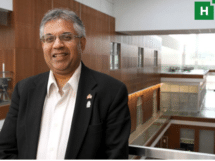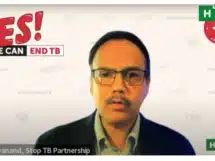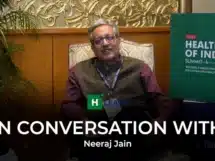Dr. Chandrakant Lahariya is a noted physician and public health and policy expert. He is the founder-director of the Foundation For People-Centric Health Systems and the lead author of the book Till We Win: India’s Fight Against the COVID-19 Pandemic.
In an interview with HealthLeads, Dr Lahariya urges the Urban Development Ministry to work with health experts to create cities with footpaths and bicycle lanes.
“The lifestyles are changing.Even the rural people who had a habit of regular physical activity are moving to the cities, but the cities are not designed to facilitate cycling or walking,” Dr Lahariya said. “As a result, a sizable section of the population in India suffers from diabetes and hypertension.”
Is India prepared for the next pandemic? What have we done differently in 2022, compared to 2021?
We can be certain that India is definitely better prepared than it was ever to respond to any epidemic outbreak or pandemic. However, if you think about what could be done differently then, there are still some challenges that we have to address.
The disease surveillance system that exists in the country is variable. Some of the states that were doing better earlier are still doing better. And, some of the states which had a weak disease surveillance system, even they are seeing improvement. But, I’m not very confident that those states are fully prepared. What we need to remember is that there are variations in preparedness. Everyone has improved from that baseline, but there is still a lot of scope for improvement.
We’ve had so many COVID vaccines and nasal sprays. What happens now, since the government is ending the vaccination drive once the stock finishes?
I think there is not enough scientific evidence to say anything conclusively about the future of COVID-19 vaccination. What we need to remember is that the two shots of the COVID-19 vaccine provide sufficient immunity. After that, though the antibody level declines, a subsequent shot of vaccine results in a further increase in this level. But we really do not know whether a fourth shot would be useful or not.
Considering India’s situation, where nearly 97 percent of the adult population has received at least one shot and over 90 percent have received both of them. So nearly the entire population has had at least three exposures to either the vaccines or the virus, and they are protected.
We do not have evidence, so we don’t know how long this immunity will last. It is certain that with time, the immunity will decline. There would be changes and mutations in the virus, so people might require an additional shot.
Now, what should be the interval between the third and the subsequent shot? It could be one year. It could be two years. It also depends on the emergence of new variants..So we have to wait for more information.
With that backdrop, I personally don’t foresee the immediate need for another shot. But we should keep track of the various COVID variants. That will help us arrive at the right decision.
What are the learnings from Delhi’s Mohalla Clinic Model for the rest of the country?
One thing is is that there is a need for spending on the primary healthcare system in every part of India. We need health services which are accessible, available, and affordable. And it would be great, if it’s being delivered by the government free for its citizens at the point of use.
By this yardstick, India has one of the weakest primary health care systems. So any system which is designed to provide primary healthcare closer to the people, especially the marginalized people, is the right step and most welcome. Mohalla clinics does exactly that. They provide free medical care by qualified providers along with the diagnostic services and medicines. They are the right step in the direction of extending primary healthcare.
Some other Indian states have adopted Mohalla clinics but with different names such as ‘basti dawakhana’ in Telangana State and other Indian states have also adopted these at a smaller scale. This is an important initiative. The bigger success in my opinion of Mohalla Clinic or Basti dawakhana is that they have brought health to the policy and political attention, and that itself is a success.
That said, I also want to emphasize that one of the weaknesses of this initiative is that the clinics focus far too much on medical care. A stronger primary healthcare essentially means medical or curative care, plus essential public health services. So all states need to provide primary healthcare. They can start with something like mohalla clinics or curative services. But even the Delhi government which introduced mohalla clinic needs to think of adding essential public health services in the system.
What are the two things that can be done to save people from air pollution?
The worsening of air quality towards the end of year in Delhi has been happening for so many years. It reflects the deeper melody of India’s healthcare system and also the public policy system. This reminds us of the fact that when the problem stares us in the face we start to give a semblance of acting upon it. And then the problem is usually resolved on its own rather than intervention by the authorities.
Any problem requires a lasting solution. So every year around October or November there should be debate and discussion by technical experts, policy makers and politicians who talk about air pollution. If we want to really solve the challenge of air pollution, we need to address the factors contributing to it well in advance. The action should be taken round the year, rather than acting when we have worsening of air quality in the city.
Currently, what is one of the country’s biggest healthcare challenges and opportunities?
India definitely has made a lot of progress in the health sector over the past 75 years. However, this progress does not meet the reasonable expectations of citizens. We have moved on from the life expectancy of 32 years at the time of independence, it is now 69 years. So this is definitely good progress. However, as a civilized and responsible nation, we cannot simply keep celebrating our successes and not think of the challenges that are still pending. One of the key challenges in front of India is the emergence of non-communicable diseases. There is a high burden of the risk factors for cardiovascular diseases. The lifestyles are changing. Even the rural people who had a habit of regular physical activity are moving to the cities, but the cities are not designed to facilitate cycling or walking.
A large proportion of India’s population is affected by diabetes and hypertension due to lifestyle factors and urbanization related challenges. Footpaths are disappearing. There are no cycling tracks and people are really busy.
So what should be done? One of the best ways is by extending primary healthcare, focusing on preventive interventions, and implementing these interventions across the sector. The health sector needs to work with other sectors. We need to raise awareness about adopting a healthy lifestyle. We need to work with the Urban Development Ministry to develop cities that have footpaths and cycling tracks.
It is also time that India focuses on school health services. We need to address school going children and suggest all the interventions which will help them adopt healthier lifestyles. So a stronger primary healthcare system, which works in collaboration with others, will be effective. That is what will make India healthy by 2047.
Also Read: How to protect yourself from air pollution? – In Conversation with Dr. Chandrakant Lahariya


















Add Comment